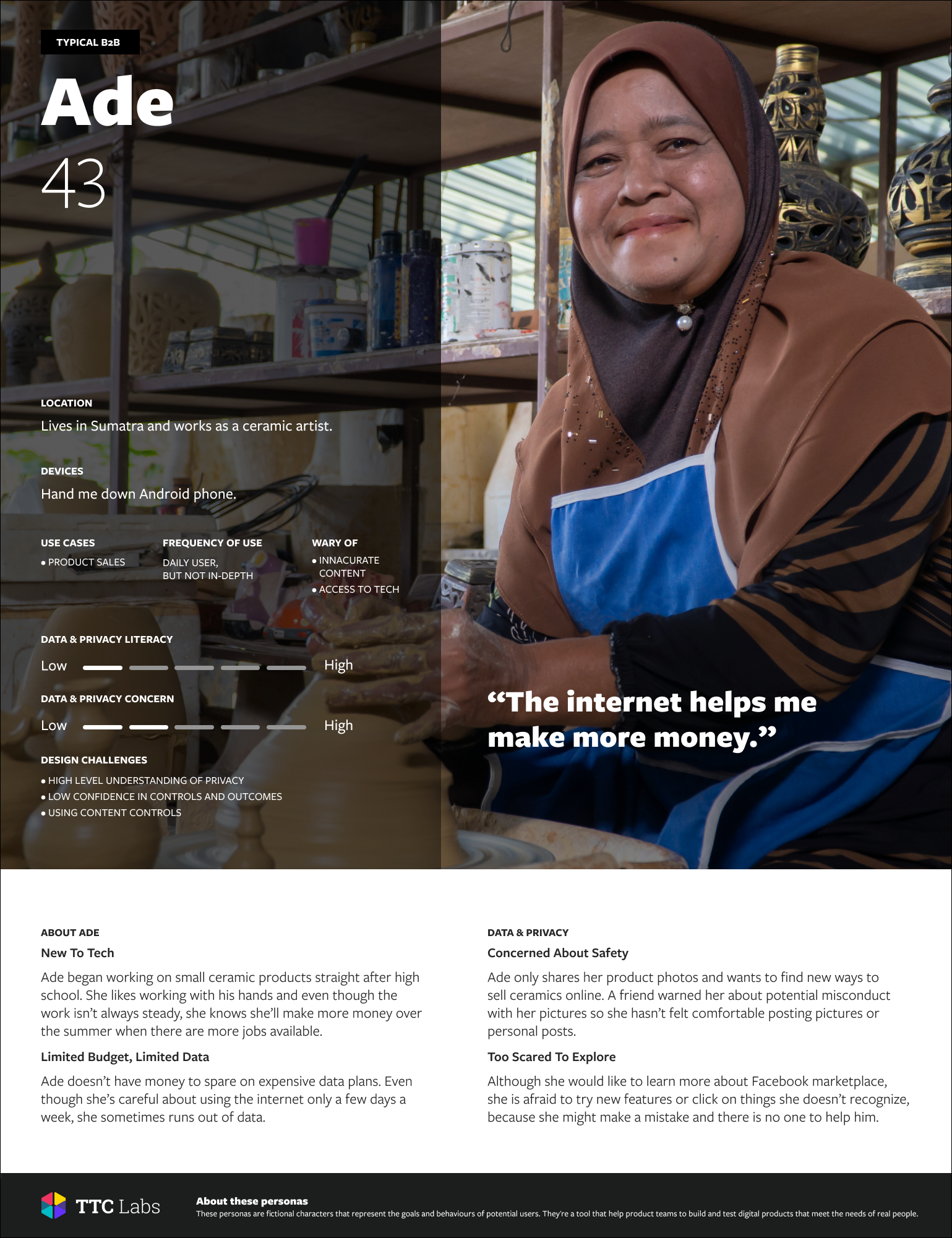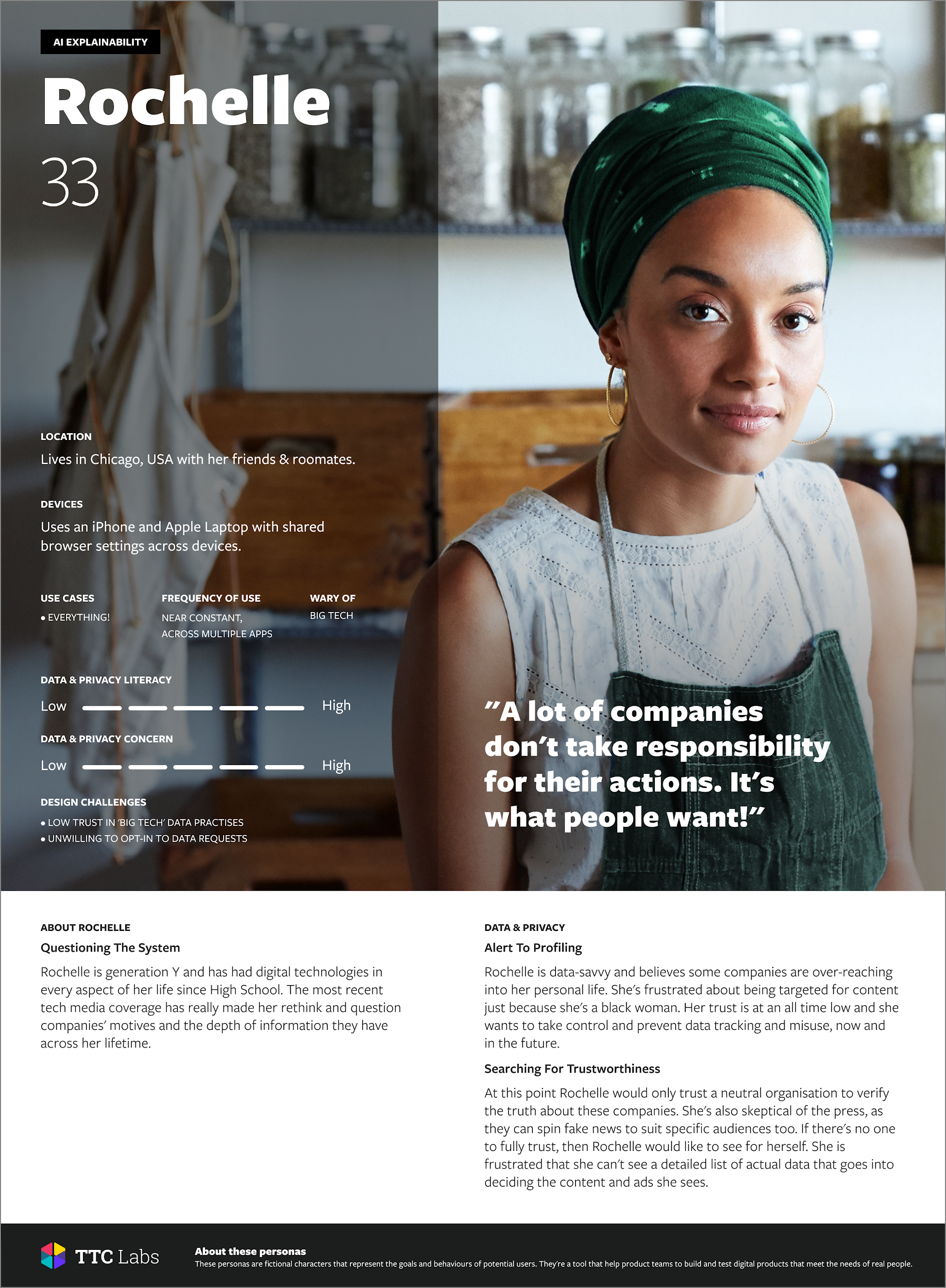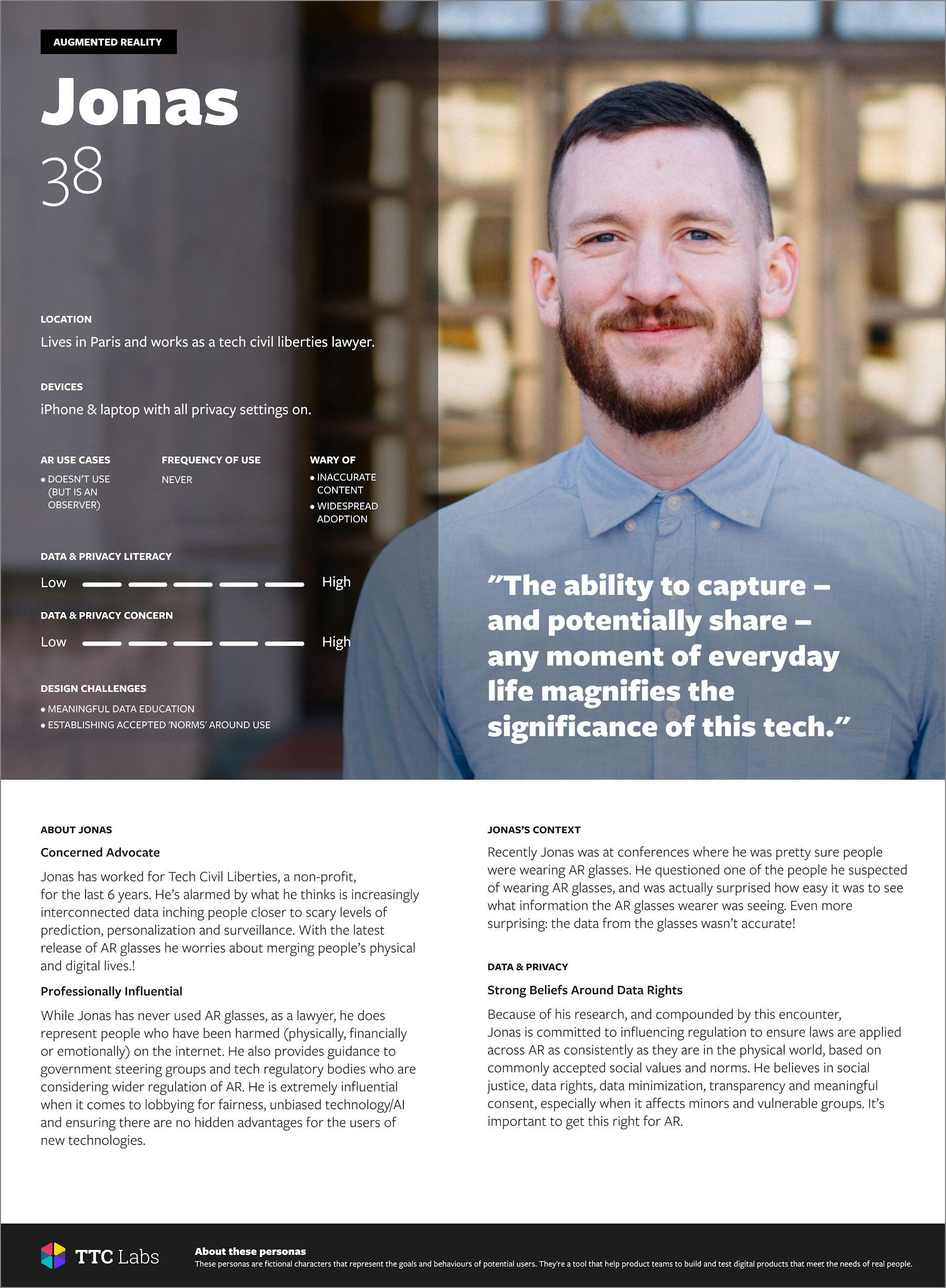Create Simple Personas
Personas are tools that help us represent the people we are designing for, their attitudes, behaviors and needs. The process of creating and using Personas reminds us to empathize with people, and solve for their specific needs when designing digital products and services.
What is it
This tool can be used to create new personas, or, if you have them, augment and reformat existing personas.
We use this exercise with Start Ups in Design Jams to create a useful persona, based on research and a first-hand understanding of the startup’s products and services. Alongside Prepare a Data Use Brief and Know Your Business, this exercise is an essential part of preparation for a Design Jam.
Understanding the people we are designing for is essential to the design process. We use Personas in our Design Jams to ensure that we are creating solutions that speak to people's needs, attitudes and behaviors, and avoid making decisions based on assumptions and stereotypes.
To be valuable, the Personas we use need to be relevant to the topic at hand and the attributes that we need to design for. Therefore, they need to be created for each design challenge - or modified from a similar challenge. You can learn more about personas in our Guide to Personas.pdf.
To really understand the diversity of your audience’s needs, we recommend creating several personas. However, creating just one persona is far better than having none.
Before we begin thinking about Personas, we must have a robust understanding of our product or service, and the challenge that we want to address. We need to have a broad design objective. Having this foundation allows us to make informed judgments about who we are designing for, and what's important to know about them.
How to do it
Gather as much information as you can about the people who buy and use your service. The information you gather should be a mixture of quantitative data and qualitative insights, drawn from both primary sources like interviews and observation, and secondary sources like reports and articles.
If your team has an existing set of personas, these can be used as part of the research base for this exercise. However, it's important to not use personas generically. To be valuable, personas need to explore behavior that is highly relevant to the topic at hand.
To narrow your focus on who you should be designing for, ask yourself these questions:
- Does the scope of this design challenge itself help to define the focus? Who might benefit most from the outcome of the challenge?
- Do you want to focus on who is currently using your product, or who you would like to use your product in the future?
- Do you want to focus on the customer (the person who buys your product) or the end-user (the person who uses the product)?
- Do you want to focus on an important set of ‘atypical’ needs?
Here are three very different examples of what a persona could look like



- Typical B2B (Ade)
- Typical B2C (Rochelle)
- Extreme User: A B2C person with high sensitivities around data use (Jonas)
Personas one and two are what we might call 'typical' personas, in that they are focused on a core audience, and 'average' traits. They would quickly help us to identify some very common behaviors, attitudes and needs to design for. However, sometimes we may choose to design for an 'extreme user', someone who has very important needs that must be satisfied, but may only constitute a relative minority of the people who use the product.
Which one of these three examples scenarios is most useful for your product, and this design challenge? Use that as a reference guide going forward in this exercise.
Now, you should have an idea of who will be your persona, it's time to start creating it.
Personas are made up of attributes, encompassing the various behaviors, attitudes and needs of your persona. They are the aspects of your persona's life that are most relevant to the topic of the Design Jam. Download the template file Personas Blank Templates.zip. You will see there are a number of prompts to help fill in the persona attributes.
Download the template file Personas Blank Templates.zip. You will see there are a number of prompts to help fill in the persona attributes. 
Filling In Your Persona Template (Prompts)
Location
Where does your persona live? Are they there for a particular reason, such as for work or study?
About
What's important to them in life? What habits and behaviors are relevant to the topic? How do they relate to and use technology? What digital services do they use and why?
Context:
What situation are they in when they use your product? What are the important aspects of the product they’re using? Why might they be using, or considering your product?
Challenges:
What is the specific instance(s) of use that we are designing for? What are they trying to accomplish? What's their goal? What feelings, thoughts or actions might they be experiencing? Where do they experience confusion, frustration or other negative emotions? Why?
Data & Privacy Literacy:
What are their attitudes around data and privacy? What is their level of technical fluency and sophistication? How does this influence their behavior? What data are they willing to share, and what are they wary of?
Metrics
A scale to give a quick visual summary of how your persona compares to others across the scope of your research. Where do you think your persona rates, compared to the average population? Privacy & Data Literacy relates to a persona’s knowledge: How well does the persona understand fundamental aspects around technology, data use and privacy considerations? Privacy & Data Concern relates to a persona’s attitude: How concerned is the persona about their privacy, and data capture, storage and use in digital services?
Name, age and photo
Fill these in last, once you've got a good feel for who your persona is.
Use these prompts to create your persona. The Design Jam facilitator may provide you with additional prompts that are relevant to your particular challenge.
Read over your persona. Ask yourself:
- Does this persona feel realistic to you? Can you empathize with them? Can you imagine 'stepping into their shoes'?
- Do they embody the attitudes, behaviors and needs that you found in your research? Will solving their challenges help you design a better product?
If not, it might help to go back to your research to uncover more details and patterns of behavior to add to your persona.
If you're confident that your persona represents the behaviors, attitudes and needs that you want to solve for in this design challenge, one persona may be enough.
However, if you would like to design for a diversity of needs, then repeat the process, and create additional personas that will help communicate those needs. For example, if you are a B2B2C company, you may want to design for both an end-user, and a customer.
 If you have multiple personas, you may want to prioritize them. Nominate one persona whose satisfaction you will focus on within your design challenge. This will be your Primary Persona. The remaining personas will be Secondary Personas. Secondary Personas also need to be satisfied with your solution, but may also have additional needs.
If you have multiple personas, you may want to prioritize them. Nominate one persona whose satisfaction you will focus on within your design challenge. This will be your Primary Persona. The remaining personas will be Secondary Personas. Secondary Personas also need to be satisfied with your solution, but may also have additional needs.
Discuss with your team, and use post-it notes to mark the printed personas with 'primary' and 'secondary'.

Print out the template for the day of the workshop. Together with the data use briefs and know your business through the lens of privacy and data, this will be helpful when defining a challenge during the workshop. These persona prints should be a source of reflection and inspiration throughout the design jam, and so should be prominently pinned up and on display throughout.
This has been designed as a quick exercise to help get you started with personas. If you'd like to learn more, see our TTC Persona library, and our guides for using Personas in Design Jams, and Creating Persona Sets.



This tool and any associated downloadable assets are provided under a
Creative Commons Attribution-Share Alike CC BY-SA 4.0 International License.